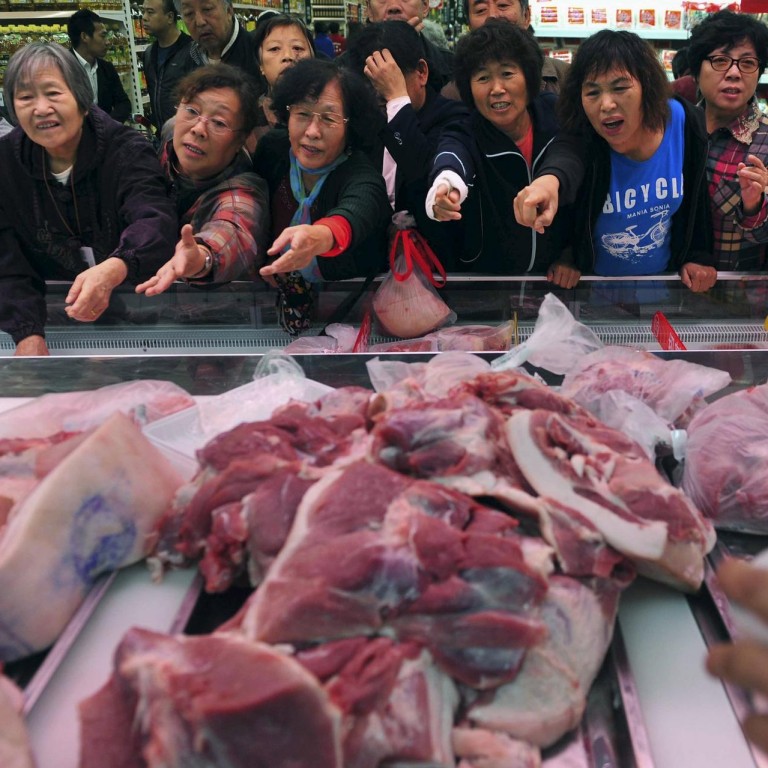
China tipped to massively increase pork imports as price of the meat soars
Germany's exports to world's biggest pork consumer expected to double
People in China eat more than half the pork consumed in the world, but domestic supplies come mainly from small farms that cut their herds whenever costs rise, causing boom-and-bust cycles that have led to record-high pig prices this year.
Wary of the social impact of such gyrations in the cost of a staple food, the government is trying to develop a more reliable food chain, but supplies are likely to remain tight until the first quarter of next year at least and imports will jump.
Rabobank is forecasting a 54 per cent increase in pork imports this year to 2 million tonnes, mainly benefiting European Union countries.
When prices surged in 2011, the government responded with subsidies to encourage pig breeding. But that led to a huge surplus and lower prices, forcing farmers to slaughter breeding sows until their numbers plunged.
Inevitably, prices turned north again, with hogs quoted at 20 yuan (HK$25) per kg now in Fujian province, up from 13.6 yuan at the beginning of the year. Fujian is home to some of the largest pig farms in the country.
“Driven by high margins, many farmers have started to replenish their farms,” said Pan Chenjun, a livestock analyst at Rabobank in Hong Kong. “They are stopping the slaughter of sows to increase production and many large pig farms are also boosting supplies.”
While small farms still account for about 80 per cent of China’s pork, the share of production from farms with more than 3,000 pigs is expanding rapidly as Beijing attempts to develop more stable food chains.

China’s largest meat producer, the privately held Shuanghui Group, acquired US pork producer Smithfield Group two years ago in a US$4.7 billion deal that was seen as a statement of intent by the country to develop a first-rate meat sector.
In the short term, however, pork supplies are likely to remain tight.
The number of breeding sows at the end of June stood at a record low of 39 million, down from an historical high of 50.1 million in 2013, according to Rabobank. The government says stocks are at the lowest since 2008 after falling for 22 months.
Rabobank says pig supplies have dropped to 384 million from an all-time high of 468 million at the end of 2013.
“Increasing the breeding sows today does not mean you’ll have small pigs tomorrow,” said Feng Yonghui, chief analyst at Soozhu.com, an industry website. “You’ll have to wait for one year for the small pigs to be ready for sale after you increase the supply of breeding sows.”
The Ministry of Agriculture is playing down the inflationary implications, saying this week that the increase in the price of pork, which it admitted was far from over, would not be as dramatic as in 2011 when it caused broad inflation to surge.
Nonetheless, the ministry called on other ministries to cut state corn prices to help reduce costs and maintain reasonable margins for pig breeders.
Even so, ANZ Bank estimates the 7 per cent year-on-year rise in average pork prices contributed to a 0.2 percentage point increase in the consumer price index for June.
Adding to the near-term supply woes is a new environmental law that is prompting provincial governments to relocate some pig farms away from urban centres.
It came into force on January 1 and authorities in places such as Fujian, Guangdong and Jiangsu provinces have already ordered farms that do not come up to scratch to close or move. In the process, even some medium-sized-to-large farms are shutting down, unable to meet the higher standards.
Annual world consumption of pork stands at around 110 million tonnes. China’s consumption is forecast to rise to 57.4 million tonnes this year, up 27 per cent from 45.1 million a decade ago, according to the US Department of Agriculture.
With local farms unable to supply that much, pork imports are expected to rise, with some analysts forecasting 2 million tonnes this year, up from 1.3 million in 2014.
China is looking to import pork from Mexico, Thailand and Brazil, industry sources said, but Germany is already one of the big winners.
Its exports to China doubled in the first half of 2015 from a year before to 83,400 tonnes, VDF, the German meat industry association, said.
“We are hopeful this level will be maintained,” said VDF’s chief executive Heike Harstick.

